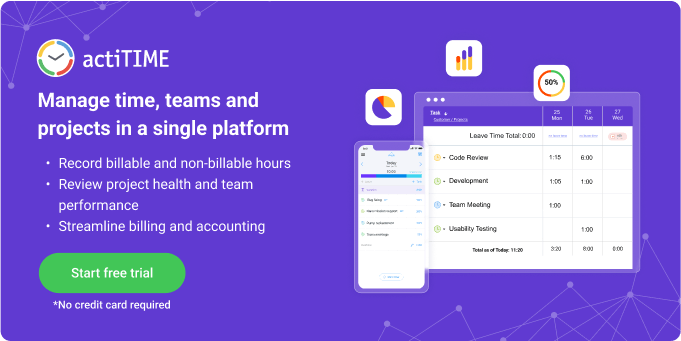10 Ways to Prioritize Tasks When Everything is Top Priority (+ Free Worksheets) ✨
10 prioritization techniques and 10 free ready-to-print worksheets to improve your task and goal planning
Table of contents
- 1. Break Master Lists into Daily To-Dos
- 2. Tell Urgent from Important with Priority Matrix
- 3. Weigh Up Your Efforts & Impact with Action Priority Matrix
- 4. Plan Your Days with Ivy Lee Method
- 5. Use Warren Buffett’s Prioritization Strategy
- 6. Jump Start Your Days by “Eating the Frog”
- 7. Score Your Priorities with ICE Model
- 8. Build Daily To-Dos with ABCDE Method
- 9. Prioritize Tasks & Ideas with MoSCoW
- 10. Keep Your Zen with an MIT List
- How to Effectively Manage Time and Priorities?
*header pic by Shen Comix
We’ve all been there: you begin jotting down your to-do list for the day and feel anxiety coming up because there’s no way you’ll be able to get all these things done today. When you try to prioritize items in your list and decide what to do first, you feel paralyzed because most tasks seem equally important and time-pressing.
If everything is called a priority, then nothing is
Being busy doesn’t mean being productive. If you are reading this article, it’s time to step off the hamster wheel and develop a new mindset to improve your quality of life. Read on to learn ten prioritization techniques that you can apply any time to plan your activities whether at work or in your daily life. Make sure to scan the whole list because there is at least one technique you’ll want to remember and use.
1. Break Master Lists into Daily To-Dos
The first thing that comes to mind when you decide to take control of your work is to list down all your tasks. Listing all the items will unload your mind, free up some mental space and give you a bigger picture of your workload.
Once you have a Master list, you can narrow it down to a daily to-do list in the following steps:
Step 1: Identify short-term and long-term activities
Step 2: Break down long-term and complex activities into doable tasks
Step 3: Set up deadlines for short-term activities and tasks
Step 4: List down activities that you hope to complete today
Step 5: Prioritize your daily to-do list
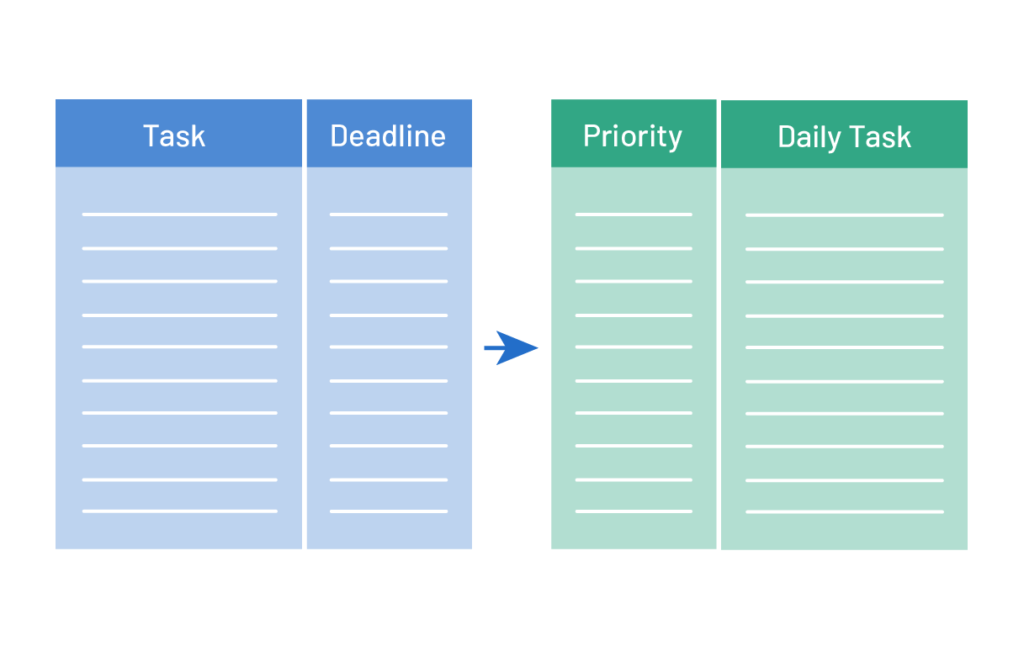
You may put and prioritize your activities on paper, but we recommend keeping an electronic backup to make sure that your data is always safe and accessible. More than that, you can get back to your lists, delete completed items, add new tasks and get a visual overview of your progress.
Tools you may like: Master List Worksheet, Google Sheets, Trello, Coggle
2. Tell Urgent from Important with Priority Matrix
If you are busy all the time, feel exhausted at the end of the day but don’t feel like you’ve accomplished something of real significance, it means that you need to learn to tell urgent things from important.
“What is important is seldom urgent and what is urgent is seldom important.” — Dwight D. Eisenhower
Urgent tasks are activities that require our immediate attention. They put us in a reactive mode — a defensive, negative, hurried, and narrowly-focused mindset.
Important tasks are things that have a long-term effect on our goals, values and mission. Typically, these tasks are not urgent and require a responsive approach when we are calm, rational, and open to new opportunities.
Taking this distinction into account, we can prioritize our plans and activities using the following matrix:
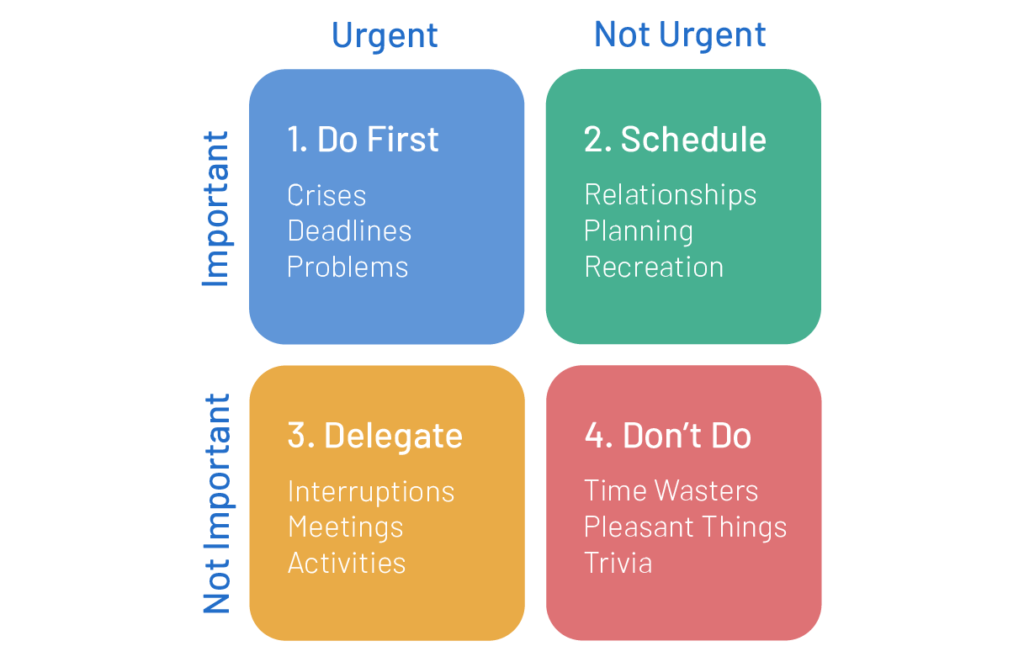
Q1: Urgent and Important Tasks — Crises
These tasks require our immediate attention, contribute to our long-term goals and usually include fire-fighting, pressing problems and deadlines. Examples: client complaints, emergencies, demands from superiors.
To manage these tasks effectively, eliminate them outright when they happen and look for ways to prevent them by developing systems and plans (Q2 tasks).
Q2: Not Urgent but Important Tasks — Plans
These include activities that bring you closer to your goals but have no strict deadlines: education and training, relationship building, risk and budget management. These tasks contribute to our goals, fulfillment and success, meaning we should invest more time in this quadrant. Unfortunately, we tend to keep these tasks on the backburner, sabotaging our personal and professional development and satisfaction. Here are the most common reasons for that:
- We forget our goals and values. Most of us tend to spread ourselves too thin, being constantly busy, feeling chronically stressed and tired. If this is the case, consider spending a few evenings defining your core values and developing your life plan.
- We waste our willpower. Willpower is a limited resource, and its capacity varies from person to person. Only when we choose long-term gain over short-term pleasures and unimportant tasks, we maximize the profit.
Maximize your time and resources in this quadrant to prevent Q1 crises, reach your goals and produce more motivation and fulfillment.
Q3: Urgent and Not Important Tasks — Interruptions
These activities require our immediate attention, sapping our time and energy without contributing to longer-term benefits. Most often, these tasks serve the goals and priorities of others and include requests from other employees, most emails, phone calls, text messages, meetings and reports. Many of us spend the most time on the Q3 tasks, thinking we are working in Q1 because helping others feels important and contributes to the “Nice Person” image.
The solution here is to balance Q3 activities with Q2 activities, develop assertiveness, renegotiate deadlines, learn to say no and delegate where possible.
Q4: Not Urgent and Not Important Tasks — Distractions
Q4 activities aren’t urgent and aren’t important meaning that they don’t help you achieve long-term goals, have no deadlines and mostly include distractions: excessive or irrelevant emails, social media, chat and gossip, procrastination. Reduce or completely avoid spending time and resources on these activities where possible.
Tools you may like: Priority Matrix Worksheet, Trello, Coggle
3. Weigh Up Your Efforts & Impact with Action Priority Matrix
The Action Matrix works in a similar way to the Priorities Matrix in that it is split up into quadrants. To use this matrix, you need to score your tasks on a scale of 1 to 10 in terms of their impact and the effort needed to complete them.
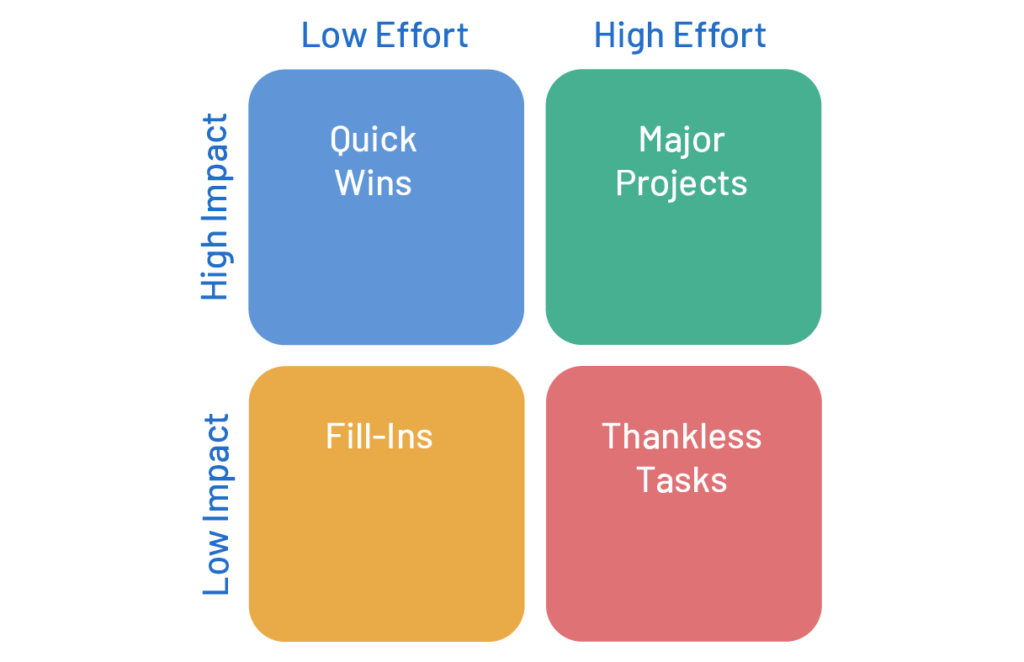
- Quick Wins (High Impact, Low Effort): the most attractive projects giving you a good return for relatively little effort. Focus on these as much as you can.
- Major Projects (High Impact, High Effort): require much research and effort but give good returns.
- Fill-Ins (Low Impact, Low Effort): low-impact tasks that you should either drop or delegate whenever possible.
- Thankless Tasks (Low Impact, High Effort): avoid these to invest your time and resources into more important tasks.
Keep in mind that you can use alternative measurements on the axis. For example, you can measure impact in terms of revenue or effort in terms of hours.
Tools you may like: Action Priority Matrix Worksheet, Trello, Coggle
4. Plan Your Days with Ivy Lee Method
In 1918, Charles M. Schwab, an American steel magnate and one of the richest men in the world, asked Ivy Lee, a renowned PR professional at the time, to come up with an idea of how to improve the efficiency of his team. In his turn, Ivy Lee requested to have a 15 minutes talk with each of Schwab’s executives and taught them the following shockingly simple but powerful approach.
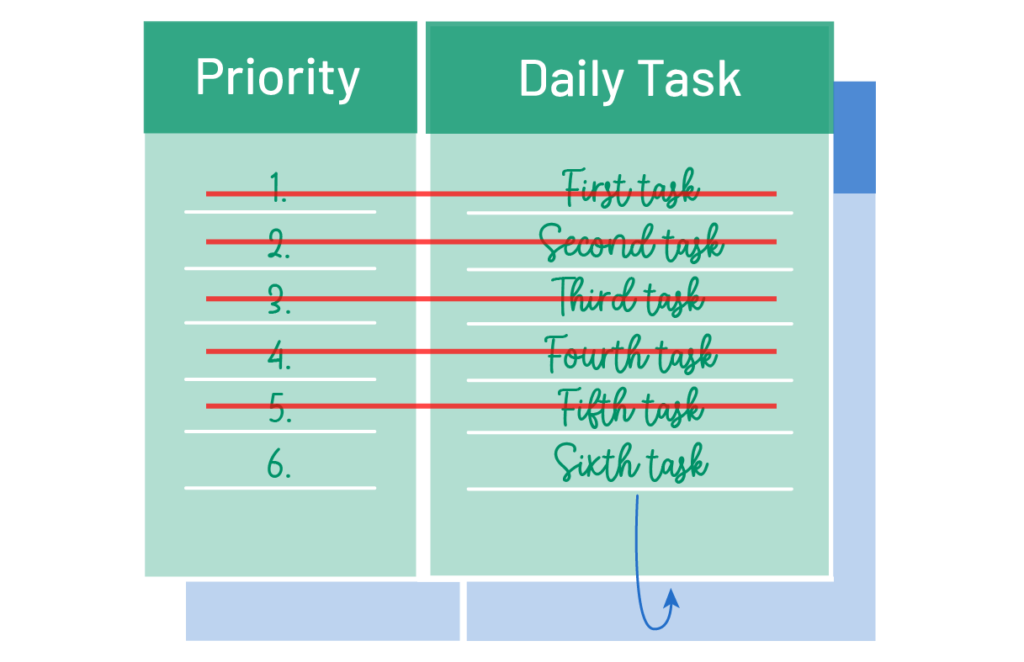
Step 1: At the end of the day, make a list of your six most important tasks that you want to accomplish tomorrow.
Step 2: Order the items in the list from most to least important.
Step 3: Tomorrow, focus on the top priority task and don’t work on anything else until it’s done. Consistency helps you to concentrate on a single thing and strengthens your focus and discipline.
Step 4: Move unfinished tasks to the next day’s list and put unfinished tasks at the top of the list. Complete the list of six tasks with more items until there are six of them.
Step 5: Repeat this process every day.
Tools you may like: Ivy Lee Worksheet, Google Keep, Trello, Excel or Google Sheets, any paper weekly planner.
5. Use Warren Buffett’s Prioritization Strategy
Owner of more than 60 companies and billionaire, Warren Buffett knows a thing or two about time management and productivity. His 2-list strategy will please only those, who stick to the following three principles:
- You know what you want
- You learn the tools that will get you there
- You maintain focus and show persistence toward your goals
If you recognize yourself in this description, consider the following approach when building your next priority list whether it’s a daily to-do or your personal development plan:
Step 1: Write down your top 25 tasks or goals that you want to accomplish for a fixed period of time. This list may contain more than 25 items but you need to limit it to 25.
Step 2: Pick your top 5 goals. Imagine that you only had the opportunity to accomplish five goals. Which would you choose?
Step 3: Focus on your top 5 items — these are your priorities now.
Step 4: Create an “Avoid at all cost” list that includes the rest 20 goals. No matter what, don’t pay attention to them and focus on your top 5 items.
Step 5: After completing the 5 important tasks, start all over with a new list of 25 tasks.
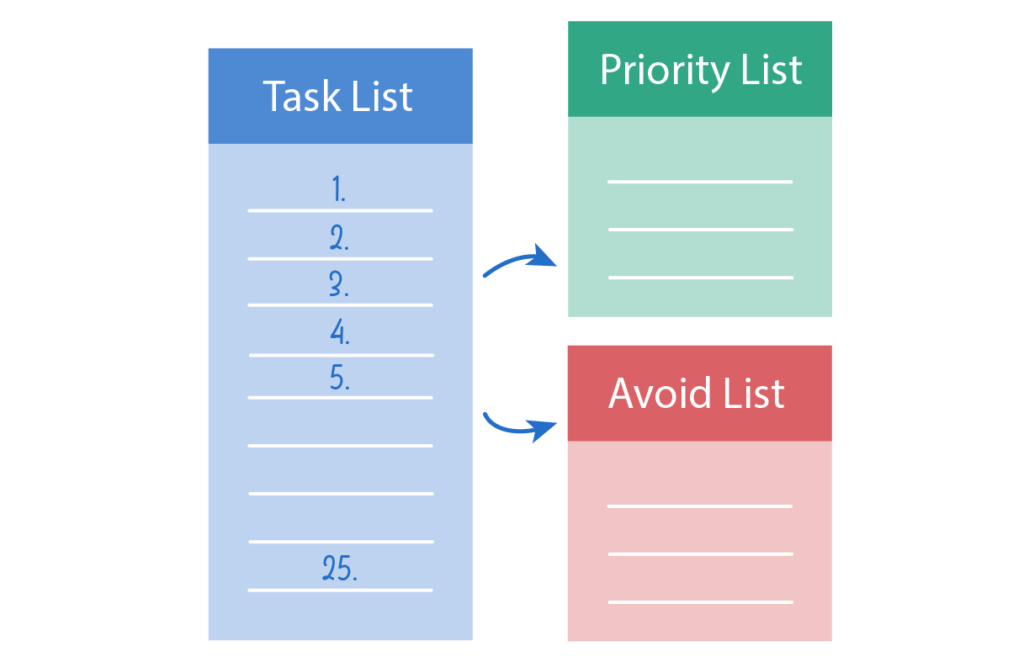
That’s it. You may argue that this technique is so simple that it looks like a fraud. But in fact, it allows you to recognize your priorities, eliminate distractions and laser-focus your attention, willpower and motivation to the most critical goals and activities.
Tools you may like: Warren Buffett’s Prioritization Worksheet, Trello
6. Jump Start Your Days by “Eating the Frog”
If you struggle with procrastination, feel overwhelmed by your to-do list and don’t feel like making any progress on the important things, you may enjoy this productivity system. The concept is simple: plan every day in advance and tackle the hardest and most important thing on your to-do list (the frog) every morning.
“Eat a live frog first thing in the morning and nothing worse will happen to you the rest of the day.” — Mark Twain
In his book Eat That Frog!: 21 Great Ways to Stop Procrastinating and Get More Done in Less Time, Brian Tracy lists 21 productivity principles along with the “eating the frog” approach. It may sound like a lot of work, but in truth, the whole system can be boiled down to the 6 following steps:
Step 1: Write down your goals
Step 2: Break these goals down into tasks.
Step 3: Break these tasks down into the smallest possible items.
Step 4: Prioritize these items, delete or delegate some of them if possible.
Step 5: Block time on your calendar every day, ideally, first thing in the morning, to work on your highest-priority or most demanding items (frogs).
Step 6: Focus on one item at a time and work on it until it’s finished.
Tools you may like: Eat the Frog Worksheet, Trello.
7. Score Your Priorities with ICE Model
The ICE Scoring Model was initially developed for choosing the next features for a product but can also be applied for prioritizing tasks and projects. The technique is based on three parameters: Impact, Confidence, and Ease.
- Impact: how impactful do I expect a task to be for my project?
- Ease: how much time and effort do I expect this task will require?
- Confidence: how confident am I about my other two estimations?
To apply this model, you need to build a list of tasks, evaluate these parameters for each item on a scale of 1–10 and calculate the ICE Score using the following formula:
ICE Score = (Impact +Confidence +Ease) / 3
Next, you need to sort your items by their score from the highest to the lowest. The top tasks in your list are the top priorities that you should focus on.
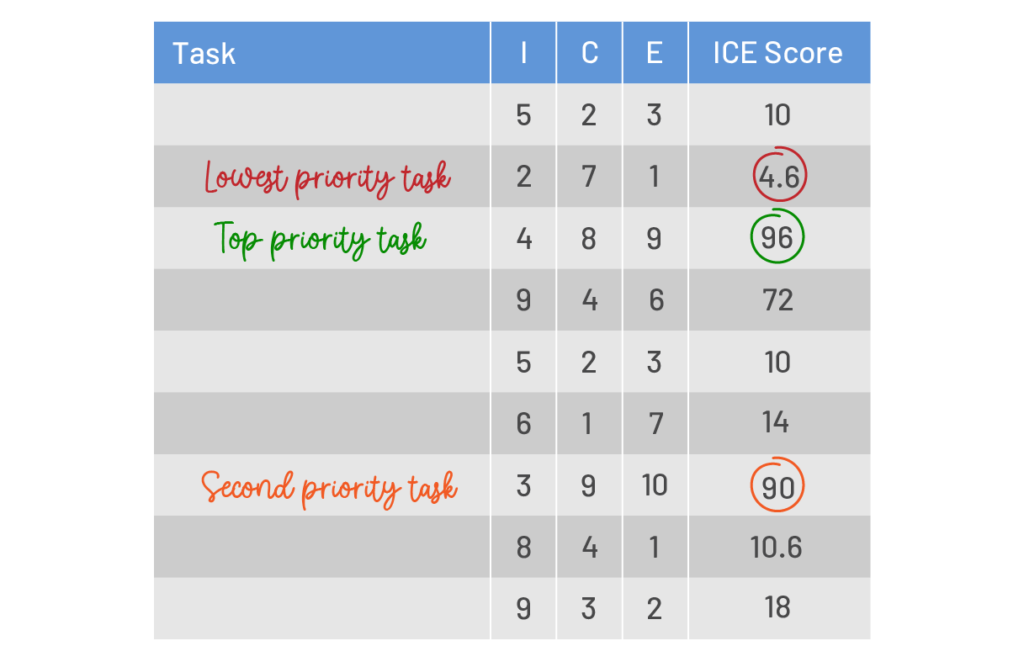
This model helps to decide between hard-to-compare ideas but is based on subjective criteria that can be scored differently by the same person at a different time.
Tools you may like: ICE Model Worksheet, Excel or Google Sheets.
8. Build Daily To-Dos with ABCDE Method
ABCDE method is a simple and effective approach for short-term planning. Whenever you feel overwhelmed by the number of tasks in your to-do list, sit back, take a deep breath and assign every item in your list one of the following letters:
- A — highest priority items: important and high-impact things you must do.
- B — medium priority items: things you should do.
- C — lowest priority items: things that are nice to do.
- D — delegate: things to delegate to have more time for A and B items.
- E — eliminate: things that you don’t need.
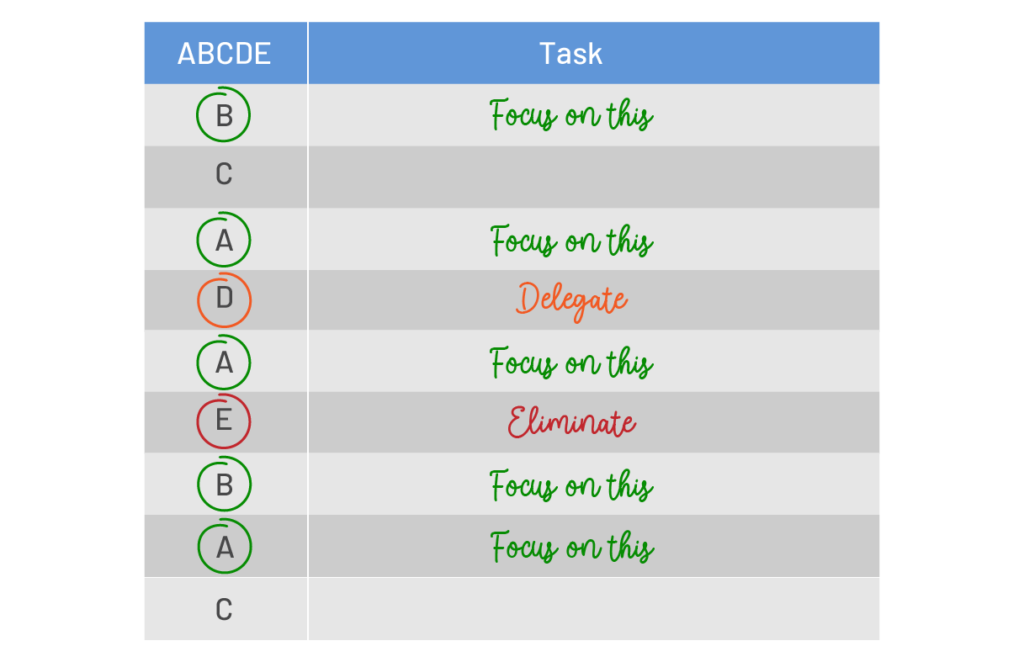
Tools you may like: ABCDE Method Worksheet, Trello.
9. Prioritize Tasks & Ideas with MoSCoW
MoSCoW is one of the easiest methods for prioritizing tasks, ideas and requirements. First announced in 1994 by Dai Clegg, this technique is still widely used in Agile projects and offers you to sort your tasks into the following groups:
- Must-haves: top-priority items that are critical for the project’s success. Can we move forward with the project if this task is undone? — if NO, it’s a Must-have.
- Should-haves: secondary items that are important but not critical at the moment. Will we move forward with the project if this task is done a bit later? — if YES, it’s a Should-have.
- Could-haves: items that are desirable but not crucial for the project’s success. Can we sacrifice this task till the deadline? — if YES, it’s Could-have.
- Won’t-haves, Would-haves or Wish-to-haves: these are the items with the lowest project impact and priority that you can either eliminate or put on the back burner.
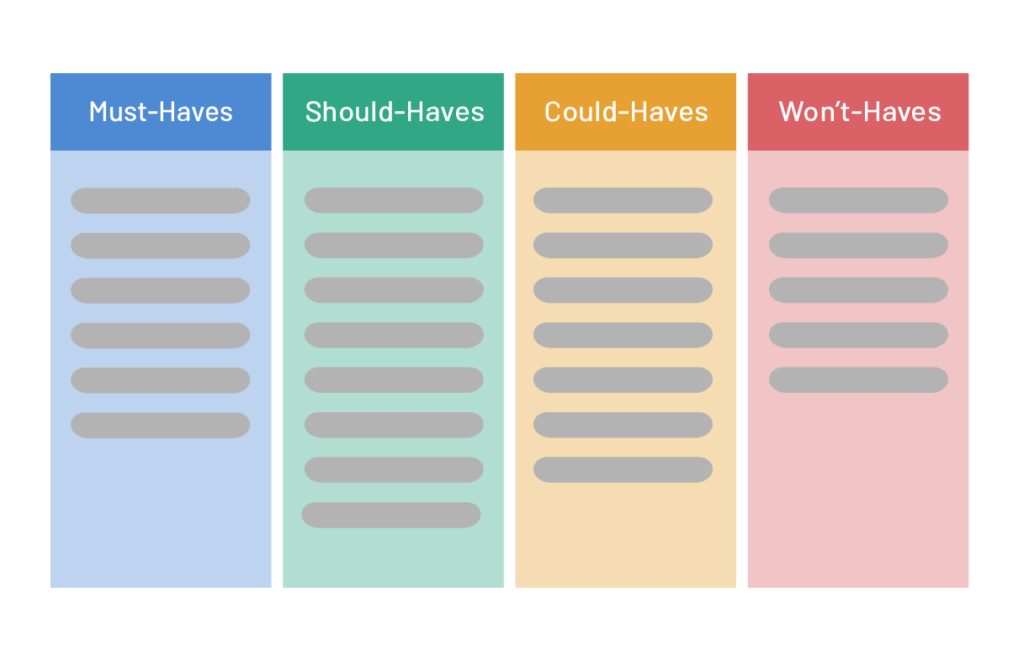
This technique will help you to prioritize tasks in short-term projects, but it doesn’t help to prioritize multiple items with the same rank and its sets are rather subjective.
Tools you may like: MoSCoW Prioritization Worksheet, Trello.
10. Keep Your Zen with an MIT List
If the above techniques sound complicated and you look for a more healthy approach to managing the avalanche of work, you may enjoy a simple approach introduced by Leo Babuta — author of one of the top 25 blogs according to TIME magazine. In his book ‘Zen to Done‘, he suggests reviewing your list of tasks at the beginning of each day and writing down 1–3 Most Important Tasks (MITs) that you would like to complete on that day. And get on with completing them.
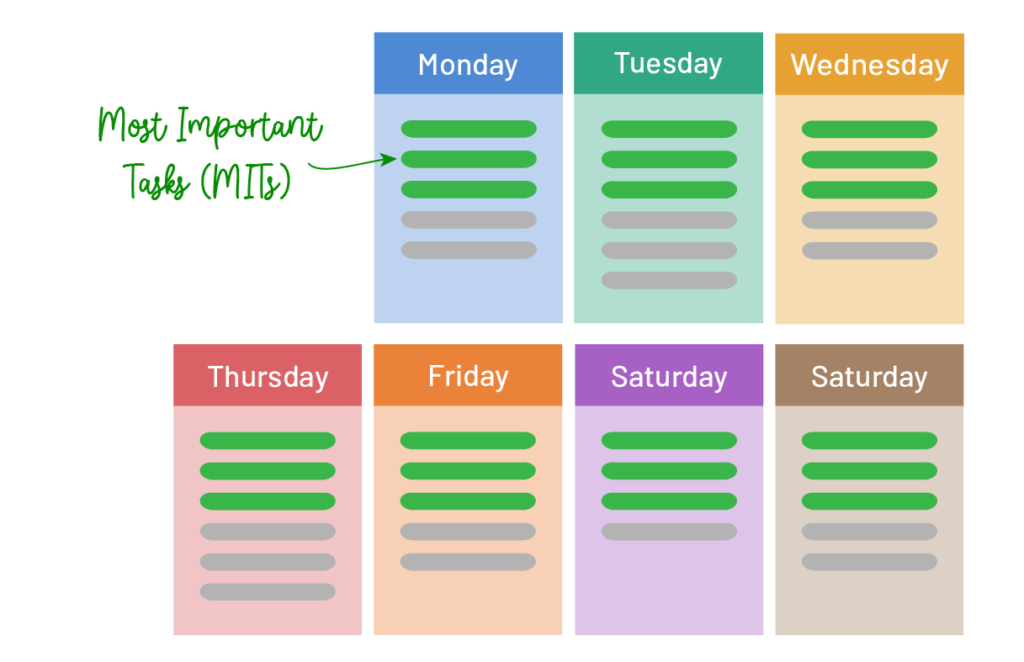
What makes this amazingly simple approach effective is that it helps you set realistic goals. When we face an overwhelming amount of work, most of us tend to make everything a priority and not complete any task in a day. Three tasks are not much, but enough to manage the crisis in a step-by-step manner and avoid burnout.
Tools you may like: MIT List Worksheet, Google Keep, Trello, any paper weekly planner.
How to Effectively Manage Time and Priorities?
Poor prioritization is one of the most common time management problems. As long as we can’t manage time, every low-impact task takes away our time that can’t be turned back. So, to maximize your productivity and profits, you need to learn to recognize important tasks, laser-focus your efforts and enjoy the results.
If you want to manage your time and activities better, consider using time tracking software. For example, in actiTIME, you can create weekly timesheets, set deadlines and estimates for tasks, use a Kanban board or task statuses to review your progress. To track time, you can use the browser extension, free mobile app or fill in the timesheet manually. Try actiTIME for free for 30 days (no credit card required).


